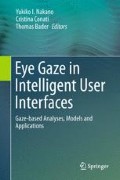Abstract
Joint attention is critical for effective communication and learning during shared reading. There is a potential disassociation of attention when the adult reads texts while the child looks at pictures. We hypothesize the lack of joint attention limits children’s opportunity to learn print words. Traditional research paradigm does not measure joint attention in real-time. In the current study, three experiments were conducted to monitor parent-child joint attention in shared storybook reading. We simultaneously tracked eye movements of a parent and his/her child with two eye-trackers. We also provided real-time eye gaze feedback to the parent about where the child was looking at, and vice versa. Changes of dyads’ reading behaviors before and after the intervention were measured from both eye movements and video records. Baseline data showed little joint attention in the naturalistic parent-child shared reading. The real-time eye gaze feedback significantly increased parent-child joint attention and improved children’s learning.
Access this chapter
Tax calculation will be finalised at checkout
Purchases are for personal use only
References
Brennan SE, Chen X, Dickinson CA, Neider MB, Zelinsky GJ (2008) Coordinating cognition: the costs and benefits of shared gaze during collaborative search. Cognition 106:1465–1477
Carletta J, Hill RL, Nicol C, Taylor T, de Ruiter JP, Bard EG (2010) Eyetracking for two-person tasks with manipulation of a virtual world. Behav Res Methods 42:254–265
Chi MTH, Siler SA, Jeong H, Yamauchi T, Hausmann RG (2001) Learning from human tutoring. Cogn Sci 25:471–533
Evans MA, Saint-Aubin J (2005) What children are looking at during shared storybook reading—evidence from eye movement monitoring. Psychol Sci 16:913–920
Evans MA, Saint-Aubin J, Landry N (2009) Letter names and alphabet book reading by senior kindergarteners: an eye movement study. Child Dev 80:1824–1841
Ezell HK, Justice LM (2000) Increasing the print focus of adult-child shared book reading through observational learning. Am J Speech-Lang Pathol 9:36–47
Feng G, Guo J (2012) From pictures to words: young children’s eye movements during shared storybook reading. J Educ Psychol (submitted)
Gong ZY, Levy BA (2009) Four year old children’s acquisition of print knowledge during electronic storybook reading. Read Writ 22:889–905
Justice LM, Skibbe L, Canning A, Lankford C (2005) Pre-schoolers, print and storybooks: an observational study using eye movement analysis. J Res Read 28:229–243
Justice LM, Skibbe L, Ezell HK (2006) Using print referencing to promote written language awareness. In: Ukrainetz TA (ed) Contextualized language intervention: scaffolding preK-12 literacy achievement. Thinking Publications University, Greenville, pp 389–428
Justice LM, Pullen PC, Pence K (2008) Influence of verbal and nonverbal references to print on preschoolers’ visual attention to print during storybook reading. Dev Psychol 44:855–866
Landis JR, Koch GG (1977) The measurement of observer agreement for categorical data. Biometrics 33:159–174
Nüssli M-A, Jermann P, Sangin M, Dillenbourg P (2009) Collaboration and abstract representations: towards predictive models based on raw speech and eye-tracking data. Paper presented at the conference on computer support for collaborative learning
Ortiz C, Stowe RM, Arnold DH (2001) Parental influence on child interest in shared picture book reading. Early Child Res Q 16:263–281
Rayner K (1998) Eye movements in reading and information processing: 20 years of research. Psychol Bull 124:372–422
Rayner K, Chace KH, Slattery TJ, Ashby J (2006) Eye movements as reflections of comprehension processes in reading. Sci Stud Read 10:241–255
Richardson DC, Dale R, Kirkham NZ (2007) The art of conversation is coordination—common ground and the coupling of eye movements during dialogue. Psychol Sci 18:407–413
Sulzby E (1985) Children’s emergent reading of favorite storybooks: a developmental study. Read Res Q 20:458–481
Whitehurst GJ, Fischel JE, Lonigan CJ, Valdezmenchaca MC, Debaryshe BD, Caulfield MB (1988) Verbal interaction in families of normal and expressive-language-delayed children. Dev Psychol 24:690–699
Author information
Authors and Affiliations
Corresponding author
Editor information
Editors and Affiliations
Rights and permissions
Copyright information
© 2013 Springer-Verlag London
About this chapter
Cite this chapter
Guo, J., Feng, G. (2013). How Eye Gaze Feedback Changes Parent-Child Joint Attention in Shared Storybook Reading?. In: Nakano, Y., Conati, C., Bader, T. (eds) Eye Gaze in Intelligent User Interfaces. Springer, London. https://doi.org/10.1007/978-1-4471-4784-8_2
Download citation
DOI: https://doi.org/10.1007/978-1-4471-4784-8_2
Publisher Name: Springer, London
Print ISBN: 978-1-4471-4783-1
Online ISBN: 978-1-4471-4784-8
eBook Packages: Computer ScienceComputer Science (R0)

